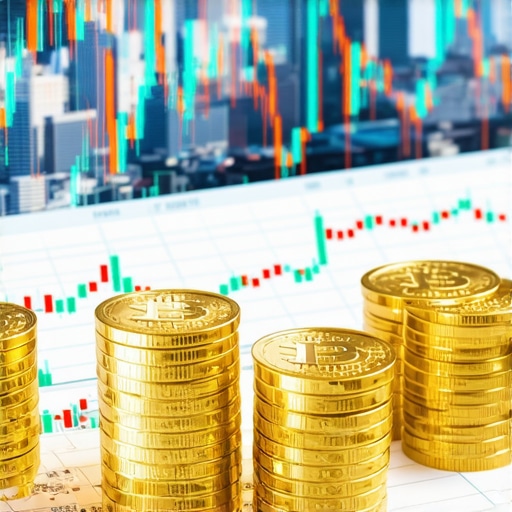The Impact of Central Bank Purchases on Gold Investment
Central banks play a pivotal role in the global economy, influencing monetary policy and financial markets. One of their significant impacts is on the gold investment landscape. Understanding how central bank purchases affect gold investment can provide investors with valuable insights into market movements and potential opportunities.
When central banks buy gold, it signals a commitment to the precious metal, often indicating a strategic move to bolster their reserves. This demand can lead to increased gold prices, providing a favorable environment for investors. As these institutions accumulate gold, they contribute to a tightening supply in the market, which can lead to price appreciation. The correlation between central bank actions and gold prices is a crucial factor for investors to consider.
Additionally, central banks often buy gold during times of economic uncertainty or geopolitical tensions. This behavior reflects a shift towards safe-haven assets, where gold is seen as a reliable store of value. For instance, when inflation rises or currency values fluctuate, gold often becomes a preferred choice for central banks looking to hedge against these risks.
Understanding the Trends in Central Bank Gold Purchases
Analyzing trends in central bank gold purchases can help investors gauge future market movements. In recent years, many central banks have increased their gold holdings significantly. According to reports, several countries, including China and Russia, have been aggressively expanding their gold reserves. This trend is not merely a reaction to current economic conditions but rather a long-term strategy to diversify their assets and reduce reliance on the US dollar.
Investors should pay close attention to these purchasing trends as they often precede significant shifts in gold prices. For example, when central banks announce substantial purchases, it can trigger a bullish sentiment in the gold market, prompting individual investors to follow suit. Moreover, understanding the motivations behind these purchases can provide insights into the broader economic landscape and inform investment strategies.
In conclusion, the relationship between central bank purchases and gold investment is complex yet significant. Investors can benefit from keeping an eye on central bank activities and understanding their implications for gold prices. For those looking to explore gold investment opportunities further, consider reading about understanding gold market dynamics and the benefits of adding gold to your investment portfolio. These resources can provide deeper insights into how to navigate the gold investment landscape effectively.
Evaluating the Influence of Central Banks on Gold Prices
The actions of central banks can significantly influence gold prices, creating a ripple effect within the investment community. When central banks decide to increase their gold reserves, it often leads to heightened demand across the market. Investors should be aware that these moves are not just reactions to immediate economic conditions; they are often part of a broader strategy to ensure financial stability and security.
Understanding how central banks manage their gold reserves can provide important clues about future pricing trends. For instance, during periods of economic instability, many central banks tend to diversify their holdings by purchasing gold, which can lead to price increases due to the heightened demand. This strategic maneuvering can create opportunities for savvy investors looking to capitalize on market fluctuations.
Key Factors Driving Central Bank Gold Purchases
Several factors drive central bank gold purchases, making it essential for investors to stay informed about these dynamics. One significant factor is the need for asset diversification. Central banks often aim to reduce their reliance on any single currency, particularly in volatile economic periods. By increasing gold reserves, they can enhance their asset base and mitigate risk.
Additionally, geopolitical tensions can spur central banks to bolster their gold holdings. For example, during trade disputes or international conflicts, gold is viewed as a safe-haven asset. This perception among central banks often leads to increased purchases, which can impact gold prices globally. Investors should monitor geopolitical developments closely, as they can provide valuable insights into potential shifts in gold demand.
Strategies for Investors to Monitor Central Bank Activities
For investors looking to navigate the complex landscape of gold investment, keeping an eye on central bank activities is crucial. Regularly reviewing reports and updates from central banks can illuminate purchasing trends and intentions. Additionally, financial news outlets often cover major announcements regarding gold purchases, providing further context for market movements.
Investors can also benefit from analyzing historical data on central bank gold purchases. Understanding past trends can help in predicting future movements and making informed decisions. For example, if a central bank has a history of purchasing gold during specific economic conditions, this information can be used to anticipate similar behavior in the future.
Integrating Central Bank Insights into Investment Strategy
Incorporating insights about central bank activities into an investment strategy can be highly beneficial. Investors should consider how these purchases align with their own investment goals and risk tolerance. For instance, if a central bank is aggressively buying gold, this could signal a favorable time to invest in gold-related assets, such as gold ETFs or physical gold.
Furthermore, understanding the broader economic context is essential. For example, if inflation rates are rising and central banks are increasing their gold holdings, this could indicate a shift towards gold as a hedge against inflation. Investors can take advantage of these insights by adjusting their portfolios accordingly.
In conclusion, grasping the nuances of central banks’ influence on gold investment is key for any investor. The connections between central bank purchases, market demand, and gold prices are intricate but important. To delve deeper into gold investment strategies, consider reading about mastering gold investment strategies or understanding gold ETFs and their benefits. These resources will equip you with the knowledge needed to navigate the gold investment landscape effectively.
Understanding Gold Market Dynamics and Investment Strategies
The gold market is influenced by a multitude of factors, including demand, supply, and macroeconomic trends. For investors, recognizing these dynamics is essential for making informed decisions in the gold investment landscape. As central banks maneuver their gold reserves, the interplay between market forces and investment strategies becomes increasingly significant.
Demand-Supply Dynamics in Gold Investment
Demand for gold is driven by various sectors, including jewelry, technology, and investments. Jewelry accounts for a substantial portion of gold demand, particularly in countries like India and China, where cultural significance plays a vital role. Furthermore, technological advancements have led to increased use of gold in electronics, enhancing its industrial demand.
On the supply side, gold mining and recycling contribute to the overall availability of gold in the market. Investors should be aware that supply disruptions, such as natural disasters or geopolitical tensions affecting mining operations, can lead to price volatility. Keeping an eye on gold market dynamics will help investors anticipate changes in pricing and adjust their strategies accordingly.
Inflation and Gold: A Hedge Against Economic Uncertainty
Gold is often viewed as a hedge against inflation, making it an attractive investment during periods of economic uncertainty. When inflation rises, the purchasing power of currency decreases, prompting investors to seek safe-haven assets like gold. As central banks increase their gold reserves, it signals a collective move towards securing financial stability, further boosting gold’s appeal as an inflation hedge.
To understand how gold functions as an inflation hedge, investors should consider historical data during economic recessions. Typically, gold prices surge as investors flock to it for security. This behavior can create opportunities for those looking to capitalize on price movements during inflationary periods. For a deeper dive into this topic, explore how gold functions as an inflation hedge.
Strategic Gold Investment Approaches
When considering gold investments, various strategies can be employed to maximize returns while mitigating risks. Diversification is key; investors should consider a mix of gold assets, including physical gold, ETFs, and mining stocks. Each option has its own set of risks and benefits, making it essential for investors to assess their financial goals and risk tolerance.
For instance, investing in gold bullion offers tangible ownership, while gold ETFs provide liquidity and ease of trading. Additionally, exploring gold mining stocks can provide exposure to the gold market without the need for physical storage. Each investment vehicle should align with the investor’s overall strategy and market outlook.
Monitoring Gold Price Trends and Market Indicators
Staying informed about gold price trends and market indicators is crucial for successful investment. Monitoring key factors such as currency fluctuations, interest rates, and geopolitical events can provide valuable insights into gold price movements. For instance, a weakening U.S. dollar often leads to increased gold prices, as gold is priced in dollars and becomes cheaper for foreign buyers.
Investors should also pay attention to gold demand trends, such as shifts in consumer behavior or technological advancements that influence industrial demand. Understanding these trends can help investors make timely decisions about when to buy or sell gold assets. To gain further insights into these trends, refer to gold demand trends, which can guide you in refining your investment strategy.
Strategies for Staying Informed on Gold Market Trends
In the ever-evolving landscape of gold investment, staying informed about market trends is vital. Investors must leverage various resources to keep abreast of changes that may affect gold prices. Utilizing financial news websites, subscribing to market analysis newsletters, and following expert blogs focused on gold price trends can provide valuable insights. These resources often highlight emerging patterns and forecasts for gold performance, helping investors make timely decisions.
Utilizing Technical Analysis for Gold Investment Decisions
Technical analysis involves studying historical price movements and trading volumes to predict future price trends. By employing various tools such as charts and indicators, investors can identify potential entry and exit points in the gold market. Familiarizing oneself with technical analysis can greatly enhance an investor’s ability to navigate market fluctuations. For instance, recognizing support and resistance levels in gold prices can inform when to buy or sell. Additionally, considering how to analyze gold price trends effectively can further improve investment outcomes.
The Impact of Global Events on Gold Prices
Global events such as political instability, economic crises, and significant developments in the financial sector can drastically affect gold prices. Investors should pay close attention to world news and economic reports that may signal changes in the market. For example, natural disasters or geopolitical tensions often lead to increased demand for gold as a safe-haven asset. Understanding how these events correlate with gold market movements can empower investors to make informed decisions that align with their investment strategies.
Exploring the Role of Central Banks in Gold Investment
Central banks play a significant role in the gold market by buying and selling gold reserves, which can influence market prices. When central banks increase their gold holdings, it often signals confidence in the asset as a store of value, leading to price increases. Investors should monitor central bank activities and their potential implications for gold prices. By understanding the role of central banks, investors can better gauge the overall sentiment towards gold and adjust their strategies accordingly.
Long-Term vs. Short-Term Gold Investment Strategies
When investing in gold, it’s crucial to define your investment horizon. Long-term investors may focus on accumulating gold as a hedge against inflation, while short-term traders may capitalize on price volatility. Each approach requires a different strategy, and understanding your financial goals is paramount. Long-term strategies often involve less frequent trading and a focus on the intrinsic value of gold, while short-term trading may require constant monitoring of market conditions and trends.
For those considering short-term strategies, employing top gold trading techniques can help maximize returns. Investors should also be aware of the risks associated with each strategy to avoid potential losses.
Comprehensive FAQ Section on Gold Investment
What are the best strategies for investing in gold?
The best strategies for investing in gold depend on your financial goals and risk tolerance. Long-term investors may prefer to buy physical gold or gold ETFs, while short-term traders might focus on gold futures and options. It’s essential to conduct thorough research and consider market trends when deciding on your strategy.
How does geopolitical instability affect gold prices?
Geopolitical instability often leads to increased demand for gold as a safe-haven asset. During times of uncertainty, investors flock to gold, driving up its price. Monitoring global events and understanding their potential impact on the market is crucial for making informed investment decisions.
What role do central banks play in the gold market?
Central banks influence the gold market by buying and selling gold reserves. When a central bank increases its gold holdings, it can signal confidence in gold as a store of value, leading to price increases. Keeping an eye on central bank activities can provide insights into market sentiment towards gold.
How can I stay updated on gold market trends?
To stay updated on gold market trends, consider following financial news websites, subscribing to newsletters, and engaging with expert blogs. Social media platforms also offer real-time updates from industry experts and analysts, providing valuable insights into market movements.
Is investing in gold a safe option?
Investing in gold is generally considered a safe option, especially during economic downturns. Gold often retains its value and can act as a hedge against inflation. However, like any investment, it carries risks, and it’s essential to conduct thorough research and assess your risk tolerance.
What are the different forms of gold investment?
Gold can be invested in various forms, including physical gold (coins and bars), gold ETFs, gold mining stocks, and gold futures. Each form has its advantages and disadvantages, and the choice depends on your investment goals and preferences.
Can gold investment provide good returns?
Gold investment can provide good returns, particularly in times of economic instability and inflation. Historically, gold has shown long-term appreciation, but short-term fluctuations can occur. Investors should have a well-defined strategy and be prepared for market volatility.
How do I analyze gold price trends?
To analyze gold price trends, investors can employ technical analysis, which includes studying historical price movements and using various indicators to predict future trends. Fundamental analysis, which considers economic factors and market sentiment, is also essential for a comprehensive view of gold prices.
What are the risks associated with gold investment?
Risks associated with gold investment include market volatility, price fluctuations, and geopolitical events that could affect supply and demand. Additionally, investing in gold mining stocks carries operational risks. It’s crucial to assess these risks and diversify your investment portfolio to mitigate potential losses.
Authority Resources for Gold Investment
For those looking to deepen their understanding of gold investment, several trusted resources can provide valuable insights and information:
- Kitco – A leading source for precious metals news, prices, and analysis.
- World Gold Council – An organization providing research and insights into the gold market.
- Investing.com – Offers up-to-date market data and analysis on gold and other commodities.
- BullionVault – A platform for buying, selling, and storing gold and silver.
- MarketWatch – Provides news and analysis on the financial markets, including gold.
- Forbes – Offers articles and insights on investing strategies and market trends.
Conclusion: Making Informed Gold Investment Choices
In conclusion, investing in gold offers a range of strategies and insights that can empower investors to make informed decisions. By understanding market trends, the impact of global events, and the roles of central banks, you can navigate the complexities of gold investment effectively. Whether you choose long-term accumulation or short-term trading, staying informed and utilizing reliable resources will enhance your investment experience. As you embark on your gold investment journey, remember that knowledge and strategy are crucial in achieving your financial goals.











It’s quite fascinating how the interplay between central bank purchases and gold prices can shape investment strategies. From my perspective, the increasing demand from central banks seems to signal more than just a temporary flight to safety; it appears to be a more persistent trend driven by the long-term economic landscape. For instance, with ongoing geopolitical tensions, the central banks’ shift towards gold reflects a broader hedge strategy against currency devaluation and economic instability.
I’ve noticed that countries like China and Russia have significantly escalated their gold reserves lately, which raises a valid point about global economic dynamics shifting away from reliance solely on the US dollar. As central banks pivot, it’s crucial for individual investors to remain agile and adapt their strategies. Monitoring not only purchase trends but also understanding their motivations can provide profound insights into potential market movements.
Additionally, I think there’s a lot to be said about integrating this data into a diversified investment portfolio. It seems that those who keep a close eye on these indicators, especially during economic uncertainty, are better positioned for opportunities in the gold market. It would be interesting to hear thoughts from others on strategies they’re employing to navigate these shifts!
Jordan, you’ve highlighted some key points about the enduring trend of central banks increasing their gold reserves, especially given geopolitical and economic uncertainties. From my experience following gold markets, it’s fascinating how these purchases not only reflect a search for security but also actively reshape the supply dynamics, which can create ripple effects well beyond immediate price movements. I’ve noticed that when central banks announce significant acquisitions, it often triggers a wave of investor confidence that goes hand in hand with portfolio diversification strategies.
However, a challenge I’ve observed is timing these market signals. Since central banks don’t always disclose their gold buying activities instantaneously or in full detail, investors often have to rely on piecing together indirect indicators and historical patterns. This makes integrating central bank activity insights into investment strategy a mix of art and science—balancing data analysis with patience.
In your view, how do you or others approach the lag between central bank moves and their reflection in market prices? Do you think this gap offers a practical window for investors to position themselves advantageously, or does it introduce risks that can catch the less experienced off-guard? I’d love to hear how fellow readers navigate this nuance in their gold investment approaches.